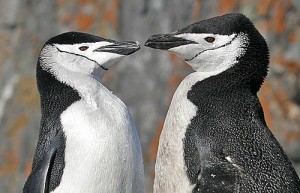Week 8 – 28 August 2016:
Well, That’s Okay If You Are A Seal, But…
Several years ago New Scientist magazine described Bouvet Island in the far south Atlantic Ocean as the only place on Earth not to have had any plant or animal species introduced by humans. It is also the locale for the 2004 horror/sci-fi film Alien vs. Predator. Further, it is one of the few places I can think of without a single bird that isn’t a seabird. Bouvet Island is almost entirely covered by ice and is, quite possibly, the most remote bit of land on the planet.
That did not deter Corne Niemandt of the University of Pretoria and seven of his colleagues from Norway and South Africa. They recently published a report on their findings concerning penguins that breed on Bouvet Island, also known as Bouvetøya. The team visited the largest ice-free spot on the island during four penguin breeding seasons between 1997 and 2008. They were particularly interested in the food brought to Chinstrap Penguin and Macaroni Penguin chicks. If we hope to understand the possible impacts of global climate change on wildlife species, then we must first understand fundamental features of their biology such as what they eat.
Adult penguins and their chicks were counted, and samples were collected from the stomachs of adult penguins during the chick-rearing period. Niemandt et al. found that Chinstrap Penguins were extremely picky eaters. Of 56 samples, all contained a type of krill with the scientific name Euphausia superba, and this one creature constituted more than 99% of the mass of stomach contents. The study population consisted of between 350 and 500 Chinstrap Penguins from 1996 to 2001. When counted again in 2008, the combined population of adults and chicks had declined by more than 80%.
Macaroni Penguins at Bouvet were more flexible in their diet. Krill were still a common food, but a range of fish species such as Electrona carlsbergi and Krefftichthys anderssoni were also eaten. The population of Macaroni Penguins declined, but not as severely as did Chinstraps.
What caused the decline in Penguin populations? Perhaps food was became less abundant, either because of physical changes in the environment or increased competition with other species such as krill-feeding whales. Niemandt and his colleagues found that most penguins were able to maintain two chicks each year, “suggesting that breeding birds are finding enough food.” Instead, it seems likely that declines in breeding penguin numbers resulted from a lack of breeding space. The breeding population of Antarctic fur seals has increased in recent years, and their colony now occupies almost all of the available space, displacing the penguins. Bouvet Island has the world’s second largest Antarctic fur seal population, with something like 66,000 of them occupying the beach where penguins attempt to breed. Landslides close to cliff edges have probably also contributed to penguin declines, displacing some and killing others.
But wait a minute… The study included a spell in the 2007/2008 Austral summer, right? According to online sources, the field station at Bouvetøya had been destroyed in 2007, likely as a result of an earthquake followed by a severe winter storm. I contacted Kit Kovacs of the Norwegian Polar Institute in Tromsø, and corresponding author on the penguin paper. She explained to me that the crew operated under difference circumstances in 2008. “The tent was a super insulated Canadian product that made a fine home for the crew,” she wrote. “We have a wonderful new station now, so the tent is old news and fading from memory.” One member was bitten by a fur seal that year, but those are the sorts of risks that a field biologist has to deal with. The scar probably serves as a reminder of a productive summer spent in a very, very remote spot.
Niemandt, C., et al. 2016. Chinstrap and Macaroni penguin diet and demography at Nyrøysa, Bouvetøya. Antarctic Science 28:91-100.
Photo credits: Chinstrap Penguins, photo by Pete Morris – www.birdquest-tours.com; Macaroni Penguins - knowledgebase.lookseek.com



